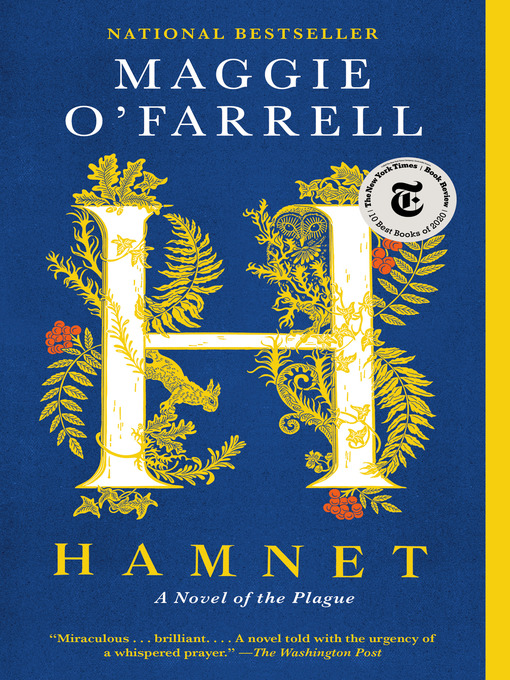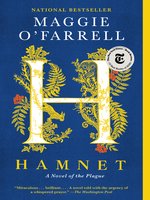-

Starred review from May 15, 2020
How were they to know that Hamnet was the pin holding them together? One ordinary afternoon in 1596, 11-year-old Hamnet's twin sister, Judith, is suddenly taken ill as the Black Death stalks Stratford's lanes. Hamnet's father is, as always, away in London. His mother, skilled with herbs and possessing a numinous second sight, recognizes she will lose one of her children. Yet even she is shocked when it is not Judith who dies, but Hamnet. Historical sources on Agnes (aka Anne) Hathaway Shakespeare are few, so O'Farrell's imagination freely ranges in this tale of deepest love and loss. Flashbacks document the Shakespeares' marriage; O'Farrell offering a gentler rendering than the traditional view. While Hamnet's death inspires aspects of Hamlet, Shakespeare is not the foremost player here ( He is all head, that one. All head, with not much sense. ); rather, it is Agnes, vibrant, uncannily perceptive, who takes center stage. While O'Farrell encapsulates atmosphere through small sensory details?golden honey dripping from a comb, the smell of lavender sprinkled into a vat of soap?she is laser-focused on human connections, their ebb and flow, and how they can drown a person. This striking, painfully lovely novel captures the very nature of grief.(Reprinted with permission of Booklist, copyright 2020, American Library Association.)
-

Starred review from May 25, 2020
O’Farrell (This Must Be the Place) concocts an outstanding masterpiece of Shakespearean apocrypha in this tale of an unnamed bard’s family living in Stratford-upon-Avon while his star is rising in London. In 1596, 11-year-old Hamnet’s twin sister, Judith, comes down with a sudden, severe illness. Hamnet searches urgently for help, and is treated cruelly by his drunken grandfather, John, a glove maker. Hamnet’s mother, Agnes, known and feared for dispensing mysterious homeopathic remedies, is at Hewlands, her family’s farmhouse. When she returns home, Judith shows undeniable signs of the bubonic plague, and the diagnosis is confirmed by a doctor. O’Farrell then tells of Agnes and her husband’s passionate courtship, and of Agnes’s stepmother banishing her from Hewlands after she becomes pregnant. The couple moves into a small, drafty addition to his parent’s house, where Agnes’s husband grows restless and melancholic in his overbearing, volatile father’s presence, and she schemes to send him to London to expand John’s business. Throughout, Agnes possesses keen premonitions and is deeply troubled when she gives birth to twins after their firstborn daughter, which contradicts a vision she’d had that the couple’s two children will stand by her deathbed. More disturbing, and unbelievable to her, is Hamnet and Judith’s sudden trading places on the sick bed. O’Farrell brilliantly explores the married couple’s relationship, capturing Agnes’s intuition that her husband is destined for great things in London, along with her frustration that his world is unknown to her. The book is filled with astonishing, timely passages, such as the plague’s journey to Stratford via a monkey’s flea from Alexandria. This is historical fiction at its best.
-

February 1, 2020
Winner of Costa, Somerset Maugham, and Betty Trask honors, the ice-pick-perceptive O'Farrell (I Am, I Am, I Am) reimagines the death of Hamnet, Shakespeare's 11-year-old son. Here, Agnes, a young healer who strolls about with a falcon on her shoulder, happily marries an impecunious Latin tutor. He's just emerging as a gifted writer when their son falls victim to the bubonic plague, and what's left is a couple shattered by grief.
Copyright 2020 Library Journal, LLC Used with permission.
-

Starred review from July 1, 2020
Imagining the life of the family Shakespeare left behind in Stratford makes an intriguing change of pace for a veteran storyteller. While O'Farrell eschews the sort of buried-secrets plots that drive the propulsive narratives of such previous novels as Instructions for a Heatwave (2013), her gifts for full-bodied characterization and sensitive rendering of intricate family bonds are on full display. She opens with 11-year-old Hamnet anxiously hovering over his twin sister, Judith, who has a mysterious fever and ominous swellings. When Hamnet asks his grandfather where his mother is, the old man strikes him, and as the novel moves through the characters' memories, we see the role John Shakespeare's brutality played in son Will's departure for London. The central figure in this drama is Shakespeare's wife, Agnes, better known to history as Anne, recipient of the infamous second-best-bed bequest in his will. O'Farrell chooses an alternate name--spelling was not uniform in Elizabethan times--and depicts Agnes as a woman whose profound engagement with the natural world drew young Will to her from their first meeting. The daughter of a reputed sorceress, Agnes has a mysterious gift: She can read people's natures and foresee their futures with a single touch. She sees the abilities within Will that are being smothered as a reluctant Latin tutor and inept participant in his father's glove trade, and it is Agnes who deftly maneuvers John into sending him away. She believes she will join Will soon, but Judith's frailty forestalls this. O'Farrell draws us into Agnes' mixed emotions as the years go by and she sees Will on his increasingly infrequent visits "inhabiting it--that life he was meant to live, that work he was intended to do." Hamnet's death--bitterly ironic, as he was always the stronger twin--drives the couple farther apart, and news of a new play called Hamlet sends Agnes to London in a rage. O'Farrell's complex, moving finale shows her watching the performance and honoring her husband's ability to turn their grief into art. A gripping drama of the conflict between love and destiny.
COPYRIGHT(2020) Kirkus Reviews, ALL RIGHTS RESERVED.








